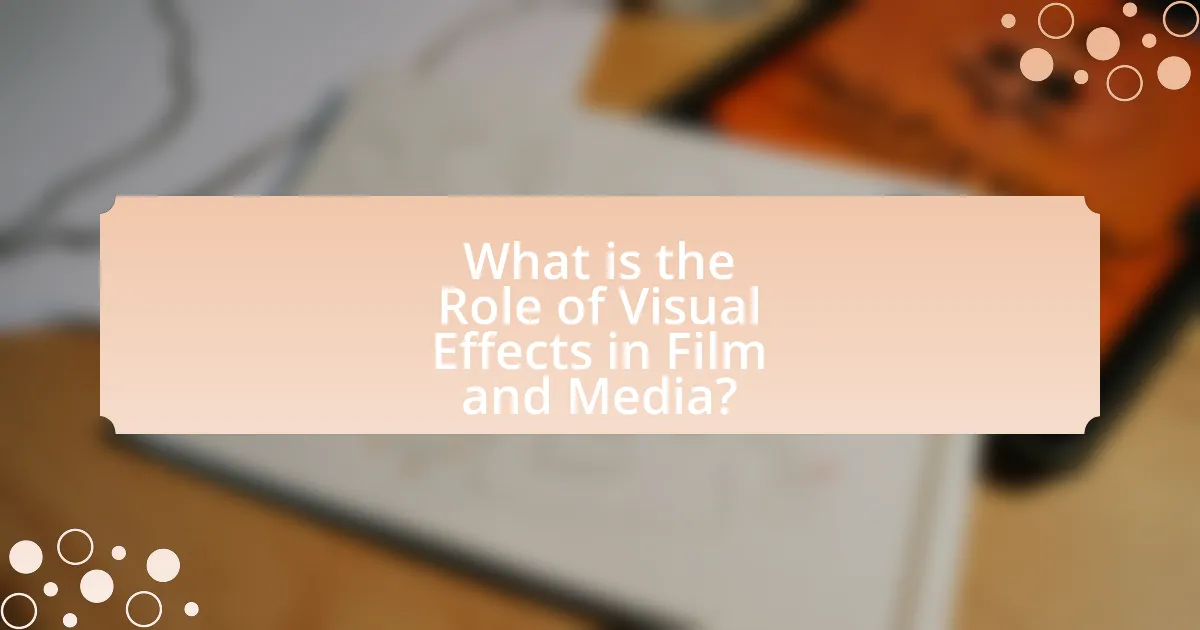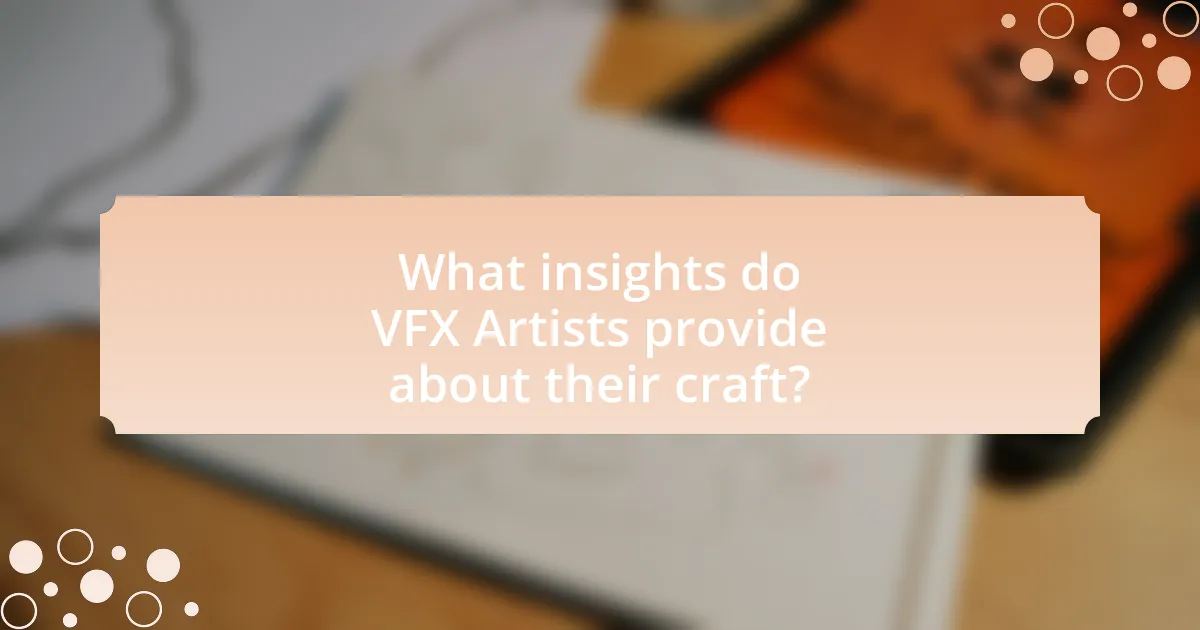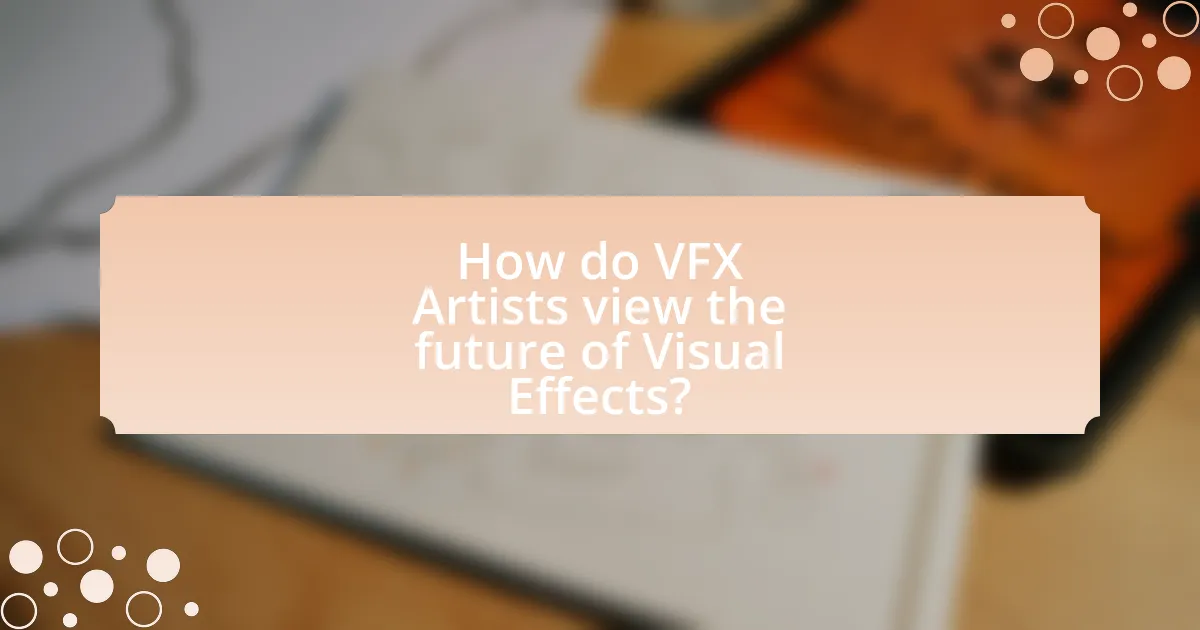The article focuses on the role of visual effects (VFX) in film and media, emphasizing their importance in enhancing storytelling and creating immersive experiences. It explores how VFX techniques, such as color grading and motion capture, contribute to emotional engagement and world-building in cinematic narratives. The article also highlights the daily responsibilities of VFX artists, the tools they use, and the challenges they face in the industry. Additionally, it discusses emerging trends and future skills necessary for VFX artists, providing insights from industry professionals on building a successful career in this field.

What is the Role of Visual Effects in Film and Media?
Visual effects (VFX) play a crucial role in film and media by enhancing storytelling through the creation of imagery that cannot be captured during live-action filming. VFX allows filmmakers to visualize complex scenes, such as fantastical environments, creatures, and action sequences, thereby expanding the creative possibilities of a narrative. For instance, films like “Avatar” and “The Lord of the Rings” utilized advanced VFX techniques to create immersive worlds and characters, demonstrating how VFX can elevate the viewer’s experience and engagement. The integration of VFX in modern cinema is essential for achieving visual realism and artistic expression, making it a fundamental component of contemporary filmmaking.
How do Visual Effects enhance storytelling in films?
Visual effects enhance storytelling in films by creating immersive worlds and visual experiences that support the narrative. They allow filmmakers to depict scenes that would be impossible or impractical to shoot in real life, such as fantastical landscapes or complex action sequences. For instance, films like “Avatar” utilized groundbreaking visual effects to transport audiences to the alien world of Pandora, thereby deepening emotional engagement with the story. Additionally, visual effects can convey themes and emotions through visual metaphors, as seen in “Inception,” where the manipulation of reality visually represents the characters’ psychological states. This integration of visual effects into storytelling not only captivates viewers but also enriches the overall cinematic experience.
What techniques are commonly used in Visual Effects to convey emotions?
Techniques commonly used in Visual Effects to convey emotions include color grading, motion blur, and facial animation. Color grading adjusts the hues and tones of a scene to evoke specific feelings; for instance, warmer colors can create a sense of comfort, while cooler tones may evoke sadness or tension. Motion blur enhances the realism of fast movements, which can amplify excitement or urgency in action sequences. Facial animation, particularly in CGI characters, allows for nuanced expressions that can communicate a wide range of emotions, making the audience empathize with the characters. These techniques are essential in creating an emotional connection between the audience and the visual narrative.
How do Visual Effects contribute to world-building in cinematic narratives?
Visual effects (VFX) significantly enhance world-building in cinematic narratives by creating immersive environments and fantastical elements that would be impossible to achieve through traditional filmmaking techniques. VFX allows filmmakers to construct entire worlds, from alien landscapes in science fiction films to magical realms in fantasy genres, thereby expanding the narrative scope and engaging the audience’s imagination. For instance, films like “Avatar” utilized groundbreaking VFX to develop the lush, vibrant world of Pandora, which became integral to the story and its themes of environmentalism and coexistence. This use of visual effects not only establishes a believable setting but also deepens the emotional connection between the audience and the narrative, as viewers are drawn into the intricacies of the created universe.
Why are Visual Effects essential in modern filmmaking?
Visual effects are essential in modern filmmaking because they enable the creation of visually stunning and immersive experiences that would be impossible to achieve through traditional methods alone. They allow filmmakers to bring imaginative worlds, complex action sequences, and fantastical elements to life, enhancing storytelling and audience engagement. For instance, films like “Avatar” and “The Avengers” have utilized advanced visual effects to create entire ecosystems and superhero powers, respectively, which significantly contributed to their box office success, with “Avatar” grossing over $2.8 billion worldwide. This demonstrates that visual effects are not just an enhancement but a fundamental component of contemporary cinematic storytelling.
What advancements in technology have influenced the use of Visual Effects?
Advancements in technology that have influenced the use of Visual Effects include the development of computer-generated imagery (CGI), real-time rendering, and motion capture technology. CGI revolutionized the industry by allowing artists to create realistic environments and characters that were previously impossible to achieve with practical effects alone. Real-time rendering, particularly with the advent of powerful graphics processing units (GPUs), enables VFX artists to visualize effects instantly, streamlining the production process. Motion capture technology has enhanced the realism of animated characters by accurately capturing human movements, which has been utilized in films like “Avatar” and video games. These technological advancements have collectively transformed the landscape of visual storytelling, making it more immersive and visually stunning.
How do Visual Effects impact audience engagement and perception?
Visual effects significantly enhance audience engagement and perception by creating immersive experiences that captivate viewers. These effects can evoke emotional responses, heighten suspense, and transport audiences to fantastical worlds, thereby increasing their investment in the narrative. For instance, a study published in the Journal of Media Psychology found that films with high-quality visual effects received higher viewer ratings and increased emotional engagement compared to those with minimal effects. This demonstrates that effective visual effects not only attract attention but also shape how audiences interpret and connect with the story being told.

What insights do VFX Artists provide about their craft?
VFX artists provide insights into the intricate balance of creativity and technology in their craft. They emphasize the importance of storytelling, stating that visual effects should enhance the narrative rather than overshadow it. Additionally, VFX artists highlight the collaborative nature of their work, often involving close coordination with directors, cinematographers, and other departments to achieve a cohesive vision. They also discuss the technical challenges they face, such as rendering complexities and the need for constant adaptation to new software and tools, which are essential for staying competitive in the industry. These insights reflect the multifaceted role of VFX artists in modern filmmaking, showcasing their contributions to both the artistic and technical aspects of visual storytelling.
What are the daily responsibilities of a VFX Artist?
A VFX Artist is responsible for creating visual effects that enhance film, television, and video game productions. Daily responsibilities include collaborating with directors and other artists to understand project requirements, designing and producing visual elements using software like Adobe After Effects and Autodesk Maya, and integrating these effects into live-action footage or animated sequences. VFX Artists also spend time reviewing and revising their work based on feedback, ensuring that the final product meets the artistic vision and technical standards of the project. This role requires a strong understanding of both artistic principles and technical skills, as well as the ability to work under tight deadlines in a team-oriented environment.
How do VFX Artists collaborate with directors and other departments?
VFX artists collaborate with directors and other departments through continuous communication and integration of visual effects into the overall production process. They participate in pre-production meetings to understand the director’s vision and requirements, ensuring that the visual effects align with the narrative and aesthetic goals of the film. During production, VFX artists work closely with cinematographers to capture the necessary footage that will later be enhanced with effects, and they coordinate with the art department to ensure consistency in design elements. This collaboration is essential for creating seamless visual storytelling, as evidenced by the fact that films with integrated VFX processes often achieve higher audience engagement and critical acclaim.
What tools and software do VFX Artists commonly use in their work?
VFX artists commonly use software such as Adobe After Effects, Autodesk Maya, Nuke, and Blender in their work. Adobe After Effects is widely utilized for motion graphics and compositing, while Autodesk Maya is favored for 3D modeling and animation. Nuke is a powerful tool for compositing and visual effects, known for its node-based workflow, and Blender is an open-source software that offers a comprehensive suite for 3D creation, including modeling, animation, and rendering. These tools are essential for creating high-quality visual effects in film, television, and video games, reflecting industry standards and practices.
What challenges do VFX Artists face in the industry?
VFX artists face several significant challenges in the industry, including tight deadlines, high competition, and the need for continuous skill development. Tight deadlines often lead to increased stress and the necessity for long working hours, which can affect the quality of work and personal well-being. High competition in the field requires artists to constantly innovate and improve their skills to stand out, as the demand for unique and high-quality visual effects continues to rise. Additionally, the rapid advancement of technology necessitates ongoing education and adaptation to new tools and techniques, which can be both time-consuming and costly. These challenges collectively impact the job satisfaction and career longevity of VFX artists.
How do tight deadlines affect the quality of Visual Effects?
Tight deadlines negatively impact the quality of Visual Effects (VFX) by limiting the time available for detailed work and thorough revisions. When VFX artists are pressured to deliver within short timeframes, they often have to prioritize speed over quality, leading to rushed animations, less attention to detail, and potential errors. A study by the Visual Effects Society found that projects with deadlines shorter than six weeks resulted in a 30% increase in reported quality issues, highlighting the correlation between time constraints and diminished output quality.
What are the common misconceptions about the work of VFX Artists?
Common misconceptions about the work of VFX artists include the belief that their job solely involves creating flashy effects and that it can be done quickly and easily. In reality, VFX artists engage in a complex process that requires a deep understanding of both artistic and technical skills, often taking months to complete even a single shot. Additionally, many people think that VFX work is entirely done on computers, overlooking the significant amount of practical effects and collaboration with other departments, such as cinematography and production design, that contribute to the final product. This complexity is supported by industry insights, which indicate that VFX production can involve hundreds of hours of work for each second of footage, highlighting the extensive effort and expertise required in this field.

How do VFX Artists view the future of Visual Effects?
VFX artists view the future of visual effects as increasingly driven by advancements in technology, particularly in real-time rendering and artificial intelligence. They believe that tools like Unreal Engine and AI-driven software will enhance creativity and efficiency, allowing for more complex and realistic visuals. For instance, the integration of machine learning in VFX workflows is expected to automate repetitive tasks, enabling artists to focus on more creative aspects of their work. This perspective is supported by industry trends showing a growing demand for high-quality visual content across various media, including film, gaming, and virtual reality, indicating a robust future for the field.
What emerging trends are shaping the future of Visual Effects?
Emerging trends shaping the future of Visual Effects include the increased use of real-time rendering technologies, advancements in artificial intelligence, and the integration of virtual and augmented reality. Real-time rendering, exemplified by engines like Unreal Engine, allows for immediate feedback and faster production times, significantly enhancing the creative process. AI is being utilized for tasks such as automating rotoscoping and generating realistic simulations, which streamlines workflows and reduces labor costs. Additionally, the blending of virtual and augmented reality into traditional filmmaking is creating immersive experiences, as seen in projects like “The Mandalorian,” which uses LED screens for background environments. These trends indicate a shift towards more efficient, innovative, and interactive visual storytelling in the industry.
How is virtual reality influencing the role of Visual Effects?
Virtual reality is significantly transforming the role of visual effects by enabling immersive experiences that enhance storytelling and audience engagement. This technology allows VFX artists to create interactive environments and realistic simulations, which are essential for VR applications. For instance, the integration of real-time rendering techniques in VR has led to a shift in how visual effects are designed, requiring artists to focus on spatial awareness and user interaction. According to a report by the International Journal of Virtual Reality, the demand for VR content has increased by over 30% annually, highlighting the growing importance of visual effects in creating compelling virtual experiences.
What skills will be essential for future VFX Artists?
Future VFX artists will need strong skills in 3D modeling, animation, and compositing. Mastery of software such as Autodesk Maya, Adobe After Effects, and Houdini is crucial, as these tools are industry standards for creating high-quality visual effects. Additionally, proficiency in programming languages like Python can enhance automation and efficiency in workflows. Understanding the principles of physics and lighting will also be essential for creating realistic effects. According to a report by the Visual Effects Society, the demand for skilled VFX artists is projected to grow by 10% over the next decade, highlighting the importance of these skills in a competitive job market.
What practical tips can aspiring VFX Artists learn from industry professionals?
Aspiring VFX artists can learn several practical tips from industry professionals, including the importance of mastering software tools, understanding the fundamentals of animation and compositing, and building a strong portfolio. Mastery of software such as Adobe After Effects, Autodesk Maya, and Nuke is crucial, as these are industry standards. Understanding animation principles, such as timing and spacing, enhances the realism of effects. Additionally, a well-curated portfolio showcasing diverse projects is essential for attracting potential employers, as it demonstrates both skill and creativity. Networking within the industry and seeking mentorship can also provide valuable insights and opportunities for growth.
How can one build a strong portfolio in Visual Effects?
To build a strong portfolio in Visual Effects, one should focus on showcasing a diverse range of skills and projects that highlight technical proficiency and creativity. This includes creating high-quality work that demonstrates expertise in various software tools, such as Adobe After Effects, Nuke, and Maya, as well as including personal projects, collaborations, and any relevant professional experience.
Additionally, participating in online challenges, contributing to open-source projects, and networking with industry professionals can enhance visibility and credibility. According to a survey by the Visual Effects Society, portfolios that include a mix of personal and collaborative projects are more likely to attract attention from potential employers.
What are the best practices for networking within the VFX community?
The best practices for networking within the VFX community include attending industry events, engaging on social media platforms, and participating in online forums. Attending events such as conferences, workshops, and film festivals allows professionals to meet peers and industry leaders, fostering relationships that can lead to job opportunities. Engaging on platforms like LinkedIn and Twitter helps individuals showcase their work, share insights, and connect with others in the field. Additionally, participating in online forums and communities dedicated to VFX provides a space for collaboration, knowledge sharing, and building a professional network. These practices are supported by the fact that personal connections often lead to job referrals, which are a significant source of employment in the creative industries.